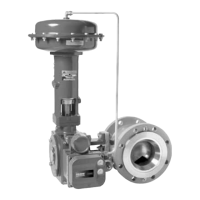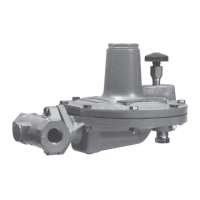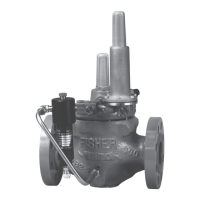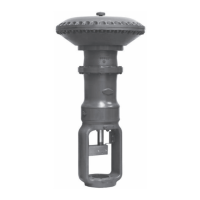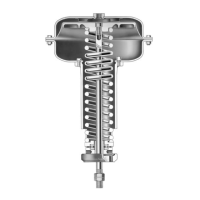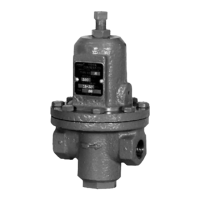Instruction Manual
D101322X012
1051 and 1052 Size 33 Actuators
June 2017
17
Disassembly
WARNING
Avoid personal injury or property damage from sudden release of process pressure or bursting of parts. Before performing
any maintenance operations:
D Do not remove the actuator from the valve while the valve is still pressurized.
D Always wear protective gloves, clothing, and eyewear when performing any maintenance operations.
D Disconnect any operating lines providing air pressure, electric power, or a control signal to the actuator. Be sure the
actuator cannot suddenly open or close the valve.
D Use bypass valves or completely shut off the process to isolate the valve from process pressure. Relieve process pressure
from both sides of the valve. Drain the process media from both sides of the valve.
D Vent the power actuator loading pressure and relieve any actuator spring precompression.
D Use lock‐out procedures to be sure that the above measures stay in effect while you work on the equipment.
D The valve packing box may contain process fluids that are pressurized, even when the valve has been removed from the
pipeline. Process fluids may spray out under pressure when removing the packing hardware or packing rings.
D Check with your process or safety engineer for any other hazards that may be present from exposure to process media.
1. Isolate the valve body from the process. Release process pressure and vent all actuator pressure.
2. If externally mounted switches are used, remove them as an assembly by removing the cap screws (key 75, figure
16) and the switch mounting plate (key 1, figure 16). In order to gain access to the cap screws, it may be necessary
to loosen the hex nuts (key 77, figure 16) and slide the switches away from the actuator housing.
3. If switches are used, mark the position of the switch mounting plate (key 59) on the actuator housing so it may be
returned to the exact same position.
4. Remove the cap screws (key 60) and the cover plate or switch mounting plate (key 59). If switches are used, leave
the push rod assemblies (keys 169 and 170, figure 16) or the proximity switch assemblies (key 7, figure 15)
undisturbed.
5. Using a 5/16 inch hex wrench, loosen the socket head cap screw (key 28) which compresses the splined lever
connection around the valve shaft.
6. Separate the actuator from the valve body by removing the cap screws and washers which secure the valve to the
mounting yoke (key 22). For some constructions of H and J mounting adaptations, it may be necessary to remove
other mounting and coupling parts.
7. If the valve body (or other operated equipment) is mounted on the housing cover (key 33) side of the actuator,
remove the mounting yoke and travel indicator pointer.
8. Remove the cap screws and washers (keys 34 and 63) and the housing cover (key 33).
9. If the actuator is equipped with a positioner, remove the positioner cam (see figure 7) by removing the two hex
head machine screws which secure the cam to the lever.
10. If the actuator is equipped with cam‐operated switches, remove the outer cam (see figure 7) with the two hex
head machine screws, spacers, and retaining washers (keys 119, 132, and 144, figures 15 and 16). Note that the
retaining washers help to keep all parts together as an assembly.
WARNING
Failure to relieve spring tension on the diaphragm rod to lever connection before removing the cap screw (key 18) may
result in personal injury and equipment damage from sudden and forceful movement of the diaphragm rod. Relieve spring
tension by performing the operations described in the next step.
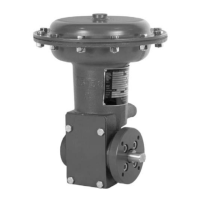
